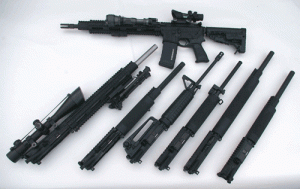 May I have extra uppers or butt stocks for my SBR in the same gun safe as Title 1 lowers?
May I have extra uppers or butt stocks for my SBR in the same gun safe as Title 1 lowers?
There is a lot of confusion regarding the concept of constructive possession as it relates to components which can be assembled to make a regulated firearm (in this case an SBR).
And people are right to be concerned. There are a number of cases affirming the idea that components do not need to be completely assembled to make them a ‘firearm’ under certain section of the law.
In 1966, the 3rd Circuit Court of Appeals held in United States v. Kokin (365 F. 2d 595) that a carbine together with all parts necessary to convert it into a machinegun is a machinegun. In 1971 the 7th Circuit Court of Appeals reaffirmed this concept in United States v. Zeidman (444 F. 2d 1051) where the court held that a pistol and attachable shoulder stock found “in different drawers of the same dresser” constituted a short-barreled rifle.
So one would imagine that any combination of matching uppers or butt stocks and unregistered lowers stored in the same safe would automatically constitute an unregistered short-barreled rifle.
However, in 1992 in United States v. Thompson/Center Arms Co. (504 U.S. 505) the United States Supreme Court, in a plurality opinion, adopted an approach that can best be described as the “useful purpose” or “obvious utility” test.
In the case of an extra upper or butt stock for your SBR stored in the same safe as a matching Title 1 lower, since the upper or butt stock can be used legally with the registered SBR, it has “useful purpose” and “obvious utility” outside of the possibility of making an illegal SBR.
However, I interpret Thompson/Center Arms to also require that the Title 1 lower have an upper either attached or in the same safe which would complete a legal Title 1 firearm.
So to answer the initial question … If you follow these guidelines, I interpret Thompson to hold that you may have extra short-barreled uppers or butt stocks for your registered SBR in the same safe as matching unregistered lowers.
Disclaimer: This information is presented for educational purposes only and does not give rise to an attorney-client relationship. Additionally, I am licensed to practice law in the Commonwealth of Virginia and this answer may not be appropriate for other states.





